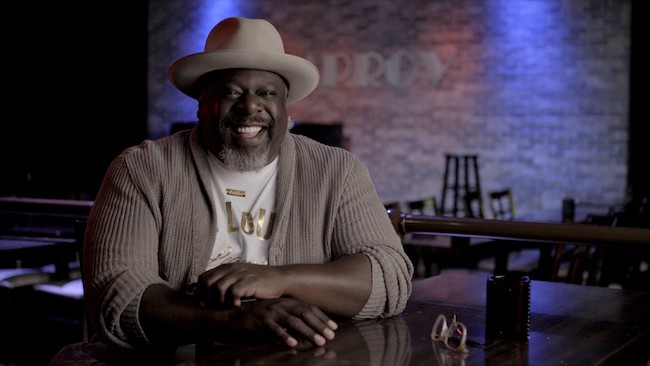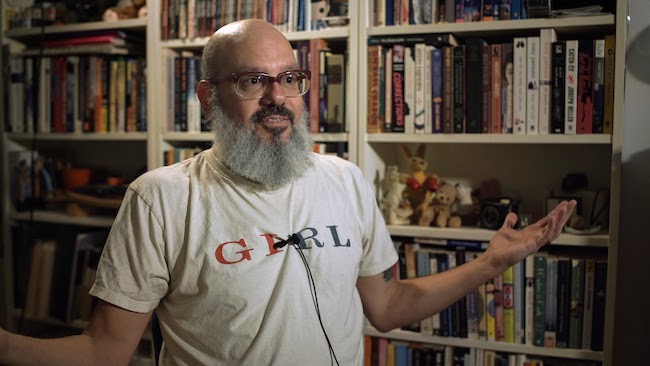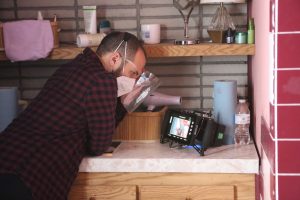Too Soon: Comedy After 9/11 is a documentary about how the comedy world tried to bring laughter back after the horror of the Sept. 11, 2001 attacks. Airing on VICE TV, it includes interviews with David Cross, Janeane Garofalo, Marc Maron, Matthew Broderick, Aasif Mandvi, Rob Riggle, Nathan Lane, Gilbert Gottfried, Cedric the Entertainer, Chris Kattan, Lewis Black, Doug Stanhope, Jimmy Carr, Russell Peters and many more. In this piece, Emmy-nominated filmmaker Nick Fituri Scown explains how he and award-winning comedy journalist Julie Seabaugh took inspiration from Werner Herzog to make the film.
The only thing I love more than Werner Herzog the filmmaker is Werner Herzog the motivational speaker. Back when I was an undergrad in college, he visited our directing class and gave one of the most inspiring lectures I’ve ever heard. The one idea that really struck a chord with me was about the power of telling someone that you’re making a movie. Not, “I’ve got this idea I’m thinking about” but, “I’m making this project. It’s happening one way or the other. You want in?”
So when my co-director, Julie Seabaugh, and I first started discussing Too Soon, and she asked how we, two first-time documentary filmmakers, could even start a project like this, I told her about wise ole Werner’s theory, and how I thought we should test it. We wouldn’t tell folks that we were thinking of doing a documentary about comedy after 9/11: We would announce to the world that we were making it.
Story continues after the trailer for Too Soon: Comedy After 9/11, by Nick Fituri Scown and Julie Seabaugh:
Of course it’s very hard to make a documentary without any camera equipment… or audio gear… or an editing system… or footage. But we were not going to let such trivial things stand in our way. So we did the one thing we could at that moment — research. We scoured the internet for any archival interviews or clips that we could use to make a sample reel of what we wanted to examine in the film, the idea of Tragedy + Time = Comedy.
Thanks to Julie’s background and connections from being a comedy journalist, we were able to get a pitch meeting with a cable channel specializing in comedy. The people there liked the idea and reel, but they weren’t ready to hop on board.
That left us with a choice. We could take our reel around town, polish our pitch and wait to see if anyone else would help us — or we could just continue making the documentary. The entire movie. Just the two of us.
Also Read: Werner Herzog on Parenting and How to Rent a Dad in Japan (Podcast)
Which to be honest, was pretty terrifying, but hell, Werner Herzog said he stole a camera to make one of his first films, so…
We borrowed equipment, and didn’t steal anything… though I may have perhaps lied a little to get press credentials to the Just For Laughs Comedy Festival in Montreal, where we went to begin filming our documentary. Julie showed the reel to some of the folks she knew in the comedy world, and that was enough to get Todd Barry and some other comics to commit to interviews. We not only got some great footage on tape, but could now see how this was going to be more than just a good idea — it would be a good movie.

Cedric the Entertainer in Too Soon: Comedy After 9/11, courtesy of Vice TV.
Inspired by what we’d got on our first shoot, we started shooting interviews with comics in L.A. on our lunch and dinner breaks from work. I would secretly cut our footage when the AVIDs at my job weren’t otherwise in use. After trading in our miles and hotel points to go film in New York, we had enough material to update and improve our reel. That got us more pitch meetings (not buyers, unfortunately) — but more importantly, it got us more interviews, as other comics could see who else was in the film and what the tone of it was. This wasn’t going to be just a series of tasteless jokes, but a respectful examination of that harrowing time, told from the POV of entertainers who weren’t sure what their place in the world was going to be after such a tragedy.
Over the course of the next year-and-a-half we compiled enough interviews to flesh out some of the major story points, particularly The Onion’s 9/11 issue and the rise of the Arab comics who formed The Axis of Evil Comedy Tour. Now people could see the narrative arc of our film play out with their own eyes; the world before 9/11, the terror of witnessing the attacks, and the feeling that the world had changed. No one knew what comedy’s place would be, but eventually entertainers realized that they needed to talk about the trauma we had all experienced. By doing so they helped us all mend.
Through making the film we’d discovered that the true equation we were examining wasn’t Tragedy + Time = Comedy, but T+T+C = Healing.
Werner’s theory was proving true. The more we made the film, the more momentum we gained. The more interviews we filmed, the more other entertainers were interested in sitting down with us. The more we edited the film, the more people could see what the film would be, which led to Julie winning a grant from Women Making A Scene that we used to finally get our own editing system, which let us start editing a rough cut of the film.
Over the course of four years, Julie and I had now built enough momentum on our own that people were ready to hop on board. The first to join the Too Soon train was Dan Baglio of Pulse Films. He had worked with Sean Hayes and Todd Millner’s production company, Hazy Mills, in making The History of Comedy for CNN. Since Julie and I already had a rough cut of the film, it was very easy for us to cut a new reel and build a pitch deck.

David Cross in Too Soon: Comedy After 9/11, courtesy of Too Soon Productions
Since we had spent so much time making the film, Julie and I were confident we could talk anyone through the story and answer any questions they had. Which we did for a lot of great distributors, but there was one in particular that stuck out to us. When we met with VICE, the people there were the first ones who didn’t want to waste time with us pitching them the story of the film. They just wanted to know how they could help us make it. These were our kind of people.
Now, after five years, we’re happy to say that we are no longer making Too Soon, because it’s been made. It’s done. It’s being released by ViceTV for all the world to see.
So, if there’s a movie you’ve been dreaming about for a long time, something you believe the world needs to see, that will help entertain, educate, or enlighten people. Then listen to Werner: Stop thinking about it and start making it.
Too Soon: Comedy After 9/11 is now airing on VICE TV. It will also screen at the Dances With Films Festival on Saturday, Sept. 11, at Hollywood’s TCL Chinese Theater.
Main image: Too Soon: Comedy After 9/11 moviemakers Nick Fituri Scown and Julie Seabaugh, courtesy of Too Soon Productions.
The post How Werner Herzog Inspired Us to Make Too Soon: Comedy After 9/11 appeared first on MovieMaker Magazine.

